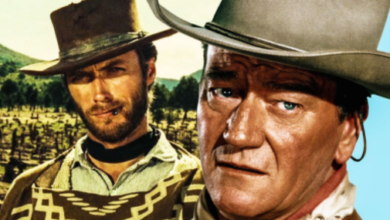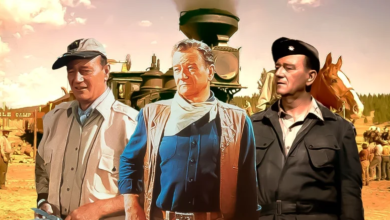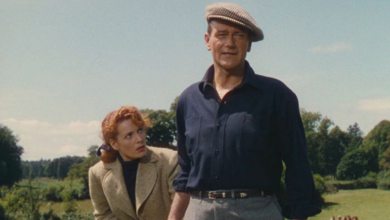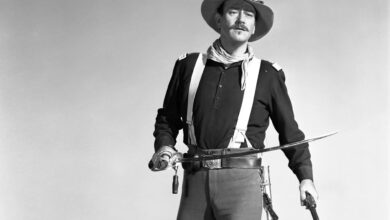True Grit: John Wayne piled on the pounds, put on an eye patch and finally won an Oscar
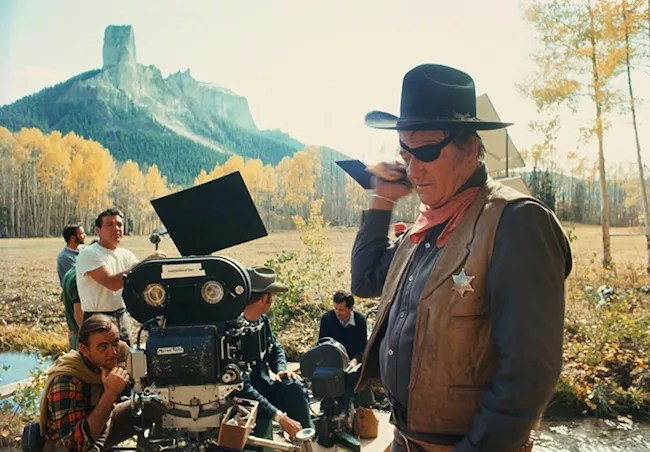
I was getting anxious because there was this young guy
called Clint Eastwood making Westerns in Italy and having
tremendous success with them. All of a sudden the studios all wanted
Eastwood to come and make Westerns for them, but they were not
the kind of Westerns I’d been making. They were tough and bleak.
I don’t get it. What do people see in these films?
That was John Wayne talking at the end of the 1960s. Wayne was sharing his insecurities with his associates about the rise of a new western star, but also a new kind of western whose popularity he failed to understand. In the sixties, the world was changing and the traditional westerns with their morally upright heroes that John Wayne embodied was not working with the audience anymore. It was the new kind of tough, cynical westerns from Italy popularly called the “Spaghetti westerns” with the new kid on the block, Clint Eastwood, that was finding favor with the audience. The success of those films and the emergence of Eastwood as a studio favorite forced Wayne to seriously ponder about the kind of westerns he was making, but more importantly his own future as a star of such films. Wayne, by his own admission, is someone who hates change. Though unknowingly he has always been part of the changing landscape of the Western. Stagecoach was a path breaking western for its time. Then Red River came along, which again pushed Western into a new direction and then finally The Searchers , which was radically different from anything that was made before. So heeding to the demands of the times, Wayne set out to find a property that will play to the sensibilities of the new age, but at the same time retain the very popular John Wayne persona. He finally found it in a new book called True Grit by Charles Portis. The role of the fat, old, one-eyed marshal named Rooster Cogburn, was a part that Wayne was born to play. Cogburn was the kind of hero not seen much on screen before. He used all means possible to catch the outlaws, though always for the greater good of the society.
In the original novel, Cogburn had a mustache and wore an eye-patch . But an image conscious Wayne didn’t want to have either thinking that his fans will not accept him . So he asked producer Hal Wallis to get rid of both. Wallis said he will get rid of the mustache but he needs to have the eye patch. Wayne thought that was a mistake, but went along with it. Wallis had hired Henry Hathaway to direct the film. Hathaway was an old John Wayne specialist, having made films like North to Alaska with him and he also insisted on the eye patch. The role carried a huge incentive for Wayne: Hathaway asked Wayne to put on weight for the role, and Wayne, who was battling a weight problem in his middle years, was delighted that he didn’t have to watch his weight on this film and could eat anything and everything he want. Hathaway also predicted that if Wayne played the role as he wanted him to, it would fetch him a best actor Oscar. Wayne just laughed off that statement. Later, after he would win the Oscar, Wayne would admit that he was wrong about almost everything about this role, except that it was perfect for him.

The main protagonist of the film was a young girl Mattie Ross, who hires Cogburn to find dreaded outlaw Tom Chaney- the man responsible for killing her father. Casting Mattie turned out to be contentious . John Wayne wanted his daughter Aissa for the role. He even promised her the part. But he didn’t realize that this was not his home production and both Hathaway and Wallis had their own ideas for casting the part. They chose Km Darby, an unknown T.V. actress for the role. So Wayne had the difficult task of telling his daughter that she is not playing the role. Wayne and Darby did not get along ԁսrıոɡ the ѕһoot. Darby was as headstrong and determined as her character and she treated Wayne throughout the making of the film exactly the way Mattie treated Cogburn. Wayne felt it had an affect on his performance as it enabled him to go all out as a performer, but he always preferred making films in an atmosphere of camaraderie. Surprisingly, Darby had only good words for Wayne and her working relationship with him: She called him simple and direct as the characters he played, which endeared him to her. The casting of the other important character in the film, Texas ranger Le Boeuf – who is also pursuing Chaney and joins forces with Cogburn against Mattie’s wishes – was in keeping in line with Wayne’s casting pattern in the 1960s. Ever since stepping into his middle years, he always had a younger , upcoming star in his films to appeal to the youth market. His pairing with Ricky Nelson in Rio Bravo was very popular. Here Hathaway chose popular singer Glen Campbell for the role. Campbell, though gave a good performance, hated working with Hathaway , who was a tough director to work for. even though Campbell did the job that Hathaway was expecting of him. He also did the the title song which won him an Oscar nomination. But no such luck for actor Robert Duvall(playing the heavy Ned Pepper), who nearly came to blows with both Wayne and Hathaway ԁսrıոɡ the ѕһoot.
John Wayne has always believed in an invisible style of acting, what he used to refer to as being sincere; always subtle and underplayed. He used to say that he got by all those years by being sincere in a scene. But this film has him putting up an exaggerated ‘Actorly’ performance. Director Hathaway allowed Wayne to do this because the character was more of a caricature and the performance was more of a send up to his past tough guy western roles, though it wasn’t exactly self-parody. Perhaps this was the reason why it was nominated and finally won an Oscar for Wayne. This was in no way his career-best performance; his performances in The Searchers and Red River are far more superior, but ironically, they weren’t even nominated. As Rooster Cogburn , we can see him straining to create this over-sized character and its not always consistent, because its not his natural style of acting. We can see the more real, natural Wayne peeping out in several instances, most particularly in the scene where he describes his past life- involving his wife and child- to Mattie. Its an extremely moving scene done in Wayne’s typical underplayed style, and rightfully, Wayne considered the scene to be one of the best in his career.
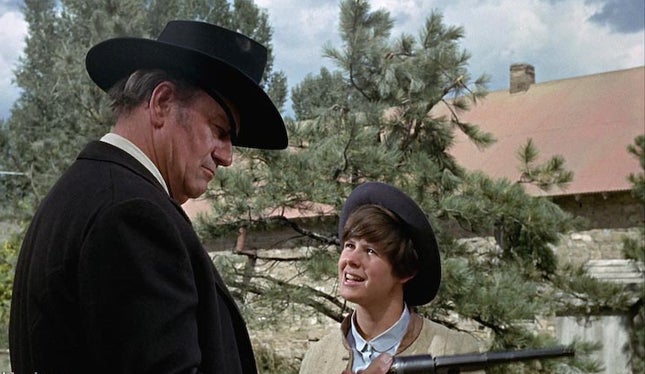
Though the lead character and performance was hyperbolic the film isn’t. It’s very much a classic western adventure story, told with a tragi-comic tone, synonymous with the stories of Mark Twain. Marguerite Roberts who wrote the screenplay was blacklisted in Hollywood, But Wayne liked the script so much that he made sure that she got credited in the film, which is ironic because Wayne was at the forefront of blacklisting artists in 1950s. But he liked the book and script so much that he actively lobbied for the role. Not that Wallis and Hathaway needed much convincing. It was impossible to imagine anybody else for the role and in this genre. The plot of the film is rather simple and similar to a lot of previous Wayne films. It mainly concerns a group of people setting out on a long journey through the west on a mission. This time its to find the killer of Mattie’s father. Cogburn, Mattie and Lebouf set out into the Indian territory to find Chaney. They get into one adventure after another. Through their adventures, they realize that Chaney has joined up with Ned Pepper. Mattie gets kidnapped by Pepper while Lebouf gets killed in the process of saving her. In the end Cogburn kills all the outlaws and saves Mattie, who is almost fatally injured after a snakebite. Hathaway, who is one tough, mean sonofabitch by his own admission, makes perhaps the best movie of his career. With the help of the great cinematographer Lucian Ballard, he captures the breathtaking landscape of Colorado in all its autumn glory. The beautiful natural landscape in all its greens and yellows gives the film a fairy tale quality. Hathaway didn’t get along with anyone on the set, except for John Wayne and he was highly critical of both Darby and Lebouf’s performances. He was all praise for Wayne: who was discipline and professionalism personified. Wayne was a man with one lung- his other lung was removed a few years ago due to Cancer- who had trouble breathing, yet he was up at dawn before anyone else. Hathaway was particularly pleased with the way Wayne prepared for the famous climactic ɡսոfıɡһt. Wayne was sixty-one then, but he he got to the set before anybody else and started rehearsing the stunt and never stopped until he could do it perfectly, so when it came time to shoot it, he could do it without taking up too much time or too many takes.
The send-up aspect of the performance is most visible in the same climax scene of the film where he utters the famous line “Fill u’r ‘ands u sonovabitch” and single-handedly charges the gang of outlaws lead by Ned Pepper- twirling ɡսոѕ in both hands and holding his reins in his teeth. He kills two of the gang and hits Pepper repeatedly. Its a highly exaggerated show of super heroism, which is more fantasy than real. But its truthful to the nature of this character in the film and it’s even more apt for the the star John Wayne, who by then had become such a legendary, larger than life figure. It’s impossible to imagine the audience buying such a scene with any other actor. Wayne, after a career almost forty years and hundred films, majority of them westerns, has earned the right to this sort of performance and such display of super-heroics. And on that account alone, his Oscar was justly deserved. Wayne was very pleased when he was nominated, but didn’t think he would win. He was up against such actors like Richard Burton and Peter O’Toole. But when the time came for presentation and Barbara Streisand called out his name as the winner, Wayne was moved to tears. He told the appreciative audience:
“Wow! If I’d known this,
I’d have put that eye patch on thirty-five years ago. Ladies and
gentlemen, I’m no stranger to this podium. I’ve come up here and
picked up these beautiful golden men before, but always for friends.
One night I picked up two, one for Admiral John Ford, one for our
beloved Gary Cooper. I was very clever and witty that night; the
envy even of Bob Hope. But tonight I don’t feel very clever, very
witty. I feel very grateful, very humble.”
True Grit had finally given him the acknowledgement of his peers that had eluded him all through his career. The award was widely considered a sentimental gesture and Wayne himself told Richard Burton after the ceremony that Burton deserved the Oscar more than him. Wayne later said that he he was having fun with the role and it was the first time he felt like an actor. It was a grand, theatrical performance; the kind that great British actors like Olivier and Burton does. But this is the kind of over the top performance that the academy loves and it was natural he would finally win an Oscar for this performance after being ignored for his great understated performances. But more than the critical acclaim, the film gave a big boost to Wayne’s career. The film was a big box office hit, revitalizing both Wayne and the Western genre. If there’d been no True Grit, or it hadn’t been so acclaimed , then its doubtful whether Wayne would have gone on to make any more westerns .Thus in 1969, John Wayne, aged sixty-two, became the top box-office star in America. For an actor who has been working close to almost forty years, it was a great achievement , beating out youngsters like Steve McQueen and Clint Eastwood. True Grit would be John Wayne’s last big hit and his only Oscar win. He passed away on June 11 1979.

